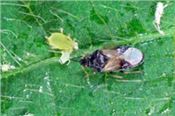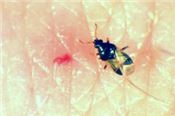Minute Pirate Bugs: Little Insect, Big Bite
JONATHAN L. LARSONJonathan L. Larson
PRINCETON, KEN.
Minute (pronounced “my-newt” not like the measurement of time) pirate bugs are insects that we often list as a beneficial species.
These tiny predators will attack and eat many different types of pest insects, including small caterpillars, thrips, spider mites, aphids, and whiteflies. They have a needle-shaped piercing-sucking mouthpart that they poke into their prey and use to suck their juices out. They often live in open meadows, backyard gardens, and in large agricultural fields. When in these environments, they often don’t interact with humans. However, as autumn comes, these habitats may be lost to mowing or harvest leading to the pirate bug venturing out into the world and occasionally landing on us. When they do, they may “probe” us with their predatory beak leaving behind a painful bite and itchy red welt. They do not feed on our blood, it’s all just one big misunderstanding that is unfortunately not comfortable for us.
Minute pirate bug description
Adult minute pirate bugs are quite small, under 1/8 of an inch in length. They are oval shaped when viewed from above. They have black bodies with a brown or tan band across the back and a white tear drop at the rear of the body where their wings overlap. Most people don’t notice them until after they have been bitten.
The immature stages are unlikely to be encountered at this time of year but are wingless, small, and have orange-yellow-colored bodies.
Can you prevent bites?
In most years, minute pirate bug bites are a sporadic issue that most folks won’t encounter. There can be outbreak years, though, where dozens of bites can be accumulated rapidly while outside.
Unfortunately, this is a problem that can be difficult to prevent.
Wearing long sleeves and dark colored clothing may help to reduce exposed skin and reduce attraction. Insect repellents usually aren’t successful in preventing bites as the pirate bug isn’t attracted to us using the same cues that biting pests, like mosquitoes and ticks, require. However, some report that DEET and other products, like oil of lemon-eucalyptus or picaridin, provided some relief. Finally, there are also anecdotal reports that applying baby oil to exposed areas of skin helped to prevent bites. ∆
JONATHAN L. LARSON: Entomology Extension Specialist, University of Kentucky

Figure 1: Adult pirate bugs are small, under an eighth of an inch long and black with a tan bar and white teardrop on their back.
Pirate bugs feed on a broad array of pest insects and are often considered biological control agents.
Photos: Jim Kalisch, University of Nebraska-Lincoln

Figure 2: A minute pirate bug next to its handiwork on human skin. The small red bite is painful and may also itch, similar to a mosquito bite.
Pirate bugs aren’t blood feeders, though; they are simply probing us when they land on humans.